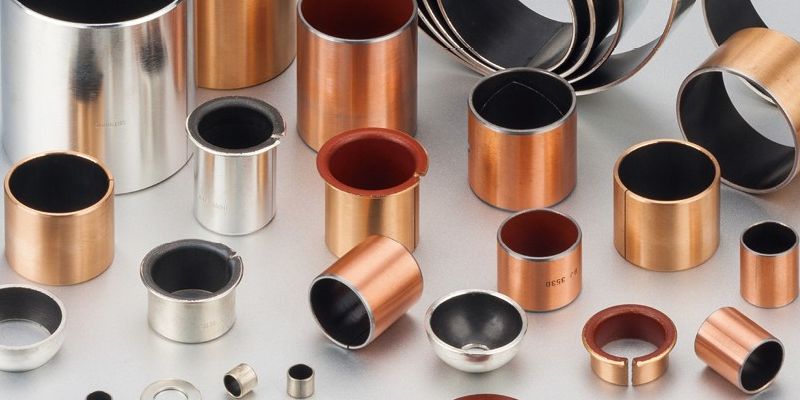마지막 업데이트 날짜: 2024년 10월 17일 Chen

바로 본론으로 들어가 보겠습니다. 저마찰 소재는 마모를 줄이는 것이 중요한 산업에서 판도를 바꿀 수 있습니다. 기계, 컨베이어 시스템, 항공우주 부품 등 어떤 분야에서 작업하든 어떤 소재를 사용하느냐가 큰 차이를 만듭니다.
그렇다면 최고의 저마찰 소재는 무엇일까요?
다음은 주요 옵션에 대한 분석이며, 여러분의 업무에 적합한 것을 결정하는 데 도움이 되는 몇 가지 실용적인 팁을 알려드리겠습니다.
PTFE(테프론®)
동적 마찰 계수: 0.10
저마찰 코팅의 왕은 PTFE입니다. 논스틱 프라이팬에 사용되는 테프론®으로 들어보셨을 겁니다. 하지만 요리에만 사용되는 것은 아닙니다. PTFE 는 화학 물질과 열에 강해 미끄러운 표면과 내구성이 필요한 분야에 적합합니다. 식품 가공 및 제약과 같은 산업에서 많이 사용합니다.
왜 PTFE를 사용하나요?
- 달라붙지 않는 표면: 쌓이는 것을 줄이고 쉽게 청소할 수 있습니다.
- 내화학성: 열악한 환경에 적합
- 내열성: 땀을 흘리지 않고 고열을 견뎌냅니다.
UHMW(초고분자량 폴리에틸렌)
동적 마찰 계수: 0.14
UHMW는 또 다른 강자입니다. 이는 자체 윤활 플라스틱으로 제작되어 유지보수가 덜 필요합니다. 컨베이어 벨트든 마모 스트립이든 UHMW는 뛰어난 내마모성 덕분에 작업을 완료할 수 있습니다.
UHMW가 돋보이는 이유는 무엇인가요?
- 자체 윤활: 그리스와 오일 사용량 감소
- 손톱만큼 견고함: 뛰어난 내구성, 거친 환경에서도 오래 지속됨
- 다용도: 습하고 건조한 환경에서 잘 작동
NYLOIL®(첨가제가 포함된 나일론)
동적 마찰 계수: 0.12
나일론 자체는 견고하지만 식물성 윤활제를 첨가하면 부싱과 같은 용도에 완벽한 NYLOIL®이 탄생합니다. 이 제품은 외부 윤활 없이도 마찰을 줄여주므로 가동 중단 시간과 유지보수가 줄어듭니다.
왜 NYLOIL®을 선택해야 하나요?
- 자체 윤활 첨가제: 마찰 감속기 내장
- 내구성: 지속적인 움직임이 있는 구성 요소에 적합
- 지속 가능성: 식물성 윤활제 사용
PEEK(폴리에테르 에테르 케톤)
동적 마찰 계수: 0.32
PEEK는 고성능 옵션입니다. 마찰 등급이 가장 낮지는 않지만 타의 추종을 불허하는 강도와 내열성을 제공합니다. PEEK는 내구성과 낮은 마찰이 모두 중요한 항공우주, 의료 및 기타 수요가 많은 환경에서 자주 사용됩니다.
PEEK는 언제 사용해야 하나요?
- 높은 강도: 극한의 환경에서도 고장 없이 처리
- 온도 허용 오차: 고온 또는 저온 애플리케이션에 이상적
- 정밀 부품에 적합: 엄격한 허용 오차가 필요한 곳에 사용
아세탈(Delrin®)
동적 마찰 계수: 0.25
아세탈은 대표적인 플라스틱입니다. 치수 안정성으로 잘 알려진 아세탈은 내습성과 정밀도가 중요한 기계 분야에 탁월합니다. 마찰이 적은 특성 덕분에 오랜 시간 동안 고정해야 하는 정밀 부품에 이상적입니다.
아세탈이 확실한 선택인 이유는 무엇인가요?
- 치수 안정성: 변화하는 환경에서도 형태 유지
- 내마모성: 반복적인 동작에도 견딤
- 내습성: 물을 흡수하거나 부풀어 오르지 않음
저마찰 소재에 대한 자주 묻는 질문:
1. 고열에 가장 적합한 저마찰 소재는 무엇인가요?
내열성이 필요한 경우 PTFE와 PEEK가 최선의 선택입니다. PTFE는 고온을 견디고 내화학성이 뛰어나며, PEEK는 열악한 환경에서 기계적 강도가 더 높습니다.
2. 어떤 저마찰 소재가 가장 비용 효율적일까요?
UHMW와 아세탈은 모두 예산 친화적이고 내구성이 뛰어납니다. 튼튼한 소재가 필요하지만 과도한 지출을 원하지 않는다면 이 소재를 선택하는 것이 좋습니다.
3. 이러한 재료를 식품 가공에 사용할 수 있나요?
예! PTFE와 UHMW는 모두 끈적임이 없고 세척하기 쉬운 특성 덕분에 식품 가공 분야에서 널리 사용되는 소재입니다.
4. 어떤 자료가 내 애플리케이션에 적합한지 어떻게 알 수 있나요?
모든 것은 필요한 것이 무엇인지로 귀결됩니다. 예를 들어 내화학성이 필요한 경우 PTFE가 적합합니다. 내마모성과 자체 윤활이 필요하다면 UHMW 또는 NYLOIL®이 더 좋을 수 있습니다. 고강도 및 내열성이 중요하다면 PEEK를 고려하세요.
최종 생각:
마찰을 줄이고 부품의 수명을 늘리려면 올바른 소재를 선택하는 것이 중요합니다. PTFE의 탁월한 논스틱 특성부터 PEEK의 고성능 기능까지, 모든 용도에 맞는 저마찰 소재가 있습니다.
아직 어떤 것이 적합한지 고민 중이라면 내구성, 비용, 온도, 내마모성 등 프로젝트에서 가장 중요한 것이 무엇인지 생각해 보세요.
이제 선택할 준비가 되었습니다!

